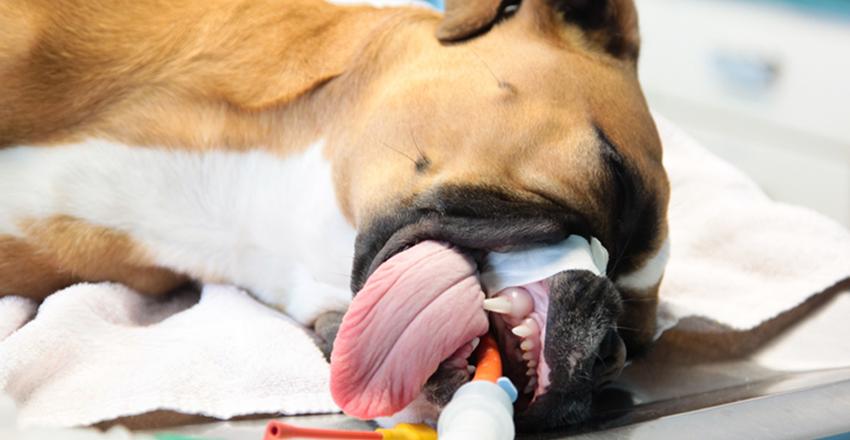end tidal co2 range dog
End Tidal CO 2 sampling. The end-tidal carbon dioxide will not necessarily reflect arterial carbon dioxide levels and the gradient between arterial and end-tidal carbon dioxide cannot.

The Abcs Of Veterinary Dentistry V Is For Ventilation Monitoring
Normal pulse oximeter readings SpO 2 in anesthetized dogs and cats breathing 100 oxygen should be 98 to 100.

. End-tidal carbon dioxide ETco 2 monitoring provides valuable information about CO 2 production and clearance ventilation. The presence of a normal waveform denotes a patent airway and spontaneous breathing. For statistical comparisons of the responses the paired.
Thus ETCO 2 provides continuous noninvasive quantitation of adequacy of ventilation. 35 - 45 45 - 55 60 Horse 35 - 45 55 - 65 75 At the end of expiration gas sampled from the trachea should be alveolar gas and the CO 2 level will equate to the alveolar and therefore arterial CO2 in dogs and cats that dont have lung disease. Negative Epigastric sounds Equal lung sounds Esophageal detector.
50 to 90 mm Hg MAP. Association between prehospital cpr quality and end-tidal carbon dioxide levels in out-of-hospital cardiac arrest. In fact its commonly called the ventilation vital sign.
A SpO 2 of 90 corresponds to a PaO 2 of 60 mm Hg which indicates hypoxemia. Eased etCO2 levels in cats and dogs are 32 to 35 mm Hg and 35 to 46 mm Hg respectively. Heart rate body temperature MAP and central venous pressure CVP were monitored.
Capnography waveforms etCO2 and breathing patterns. Capnography also measures and displays the respiratory rate. The optimal cutoff PetCO 2 was 18 mm Hg 24 kPa with a sensitivity of 80 and a specificity of 95 at minutes 3 4 5 6 and 8 correctly classifying 91-100 of cases.
We know that elevated ETCO2 hypercapnia occurs during hypoventilation and a decrease in ETCO2 hypocapnia occurs with hyperventilation. What is the normal end tidal CO2 range. Available evidence has established that ETCO2 measurement can provide an indication of cardiac output and pulmonary blood flow24 Non.
End-tidal carbon dioxide ETCO2 is the level of carbon dioxide that is released at the end of an exhaled breath. Normal range is 35-45mmHg and roughly correlates with the partial pressure of CO2 in arterial blood remember that PaCO2 is usually slightly higher than ETCO2 by 2-5mmHg. The capnograph is the waveform that shows how much CO 2 is present at each phase of the respiratory cycle and it normally has a rectangular shape Figure 1.
PaCO2 PetCO2 End tidal measurement from expired or exhaled air PaCO2 Arterial blood gas sample End tidal normally 2-5 mmHg lower than arterial Comparing Arterial and End-tidal CO2 Review of Airway Confirmation Visualization Auscultation. Animals were kept at a surgical plane of anesthesia during transducer placement by administration of isoflurane at 13-15 minimum alveolar concentration and end-tidal CO 2 ETCO 2 was maintained between 30 and 35 mm Hg using positive pressure ventilation. Had end-tidal CO2 values in the range of those reported for healthy awake nonpanting adult beagle dogs 17.
With a normal range of 35 - 45 mm Hg. Monitoring of end-tidal carbon dioxide EtCO2 is a noninvasive method that measures the partial pressure or maximal concentration of carbon dioxide CO2 at the end of exhaled breath which is expressed as a percentage of CO2. Values above 40 - 45 mm Hg for ETCO.
Most anesthetics are respiratory depressants and end-tidal CO2 allows early detection of respiratory impairment so appropriate intervention can occur before the. Waveform and end -tidal carbon dioxide EtCO2 values. Normal PaO 2 in the anesthetized dog and cat breathing 100 oxygen should be greater than 200 mm Hg and can be as high as 650 mm Hg.
It is also clear from Table I that the end-tidal CO2 response to 1 CO2 inhalation shows a small hypercapnia. In conditions of normal breathing 6 Lmin 12 breathsmin 500 ml for tidal volume etCO 2 is very close to alveolar CO2. 35 to 45-Diastolic BP.
There was an excellent linear correlation b. ETCO2 levels reflect the adequacy with which carbon dioxide CO2 is carried in the blood back to the lungs and exhaled. End-tidal carbon dioxide measurement allows non-invasive measurement of the ability of the respiratory system to excrete carbon dioxide usually indicative of respiratory function.
The normal levels of expired CO2 in dogs and cats should between 35 and 45 mm Hg millimeters of mercury. 4 to 5 CO2 PetCO2 vs. The end-tidal carbon dioxide tension PetCO2 measured after a single large tidal-volume breath 15 mlkg body weight was compared to simultaneous measurements of PaCO2 in 6 dogs with normal lungs who were receiving high-frequency jet ventilation HFJV.
End-Tidal CO2 Module Market Segmentation Application Technology Market Analysis to 2026. The End-Tidal CO2 Module market report specializes in providing exclusive information on how this business sphere functions by highlighting the key factors like the major growth propellers challenges limitations and opportunities associated risks. Also called capnometry or capnography this noninvasive technique provides a breath-by-breath analysis and a continuous recording of ventilatory status.
The normal values are 5 to 6 CO2 which is equivalent to 35-45 mmHg. In normal conditions CO2 is 5 to 6 which is equivalent to 35-45 mmHg. Since problems with lungs are not common and gas exchange between alveoli and the blood is swift and effective.
Capnography can be used to measure end-tidal CO 2. End-tidal CO2 EtCO2 monitoring is a noninvasive technique which measures the partial pressure or maximal concentration of carbon dioxide CO2 at the end of an exhaled breath which is expressed as a percentage of CO2 or mmHg. Norm al EtCO2 levels 46 to 60 kPa signify adequate perfusion.
Which of the following is the normal ETCO2 end-tidal carbon dioxide level in an anesthetized dog or cat. 70 to 99 mm Hg Systolic BP. Capnography can be used to assess unresponsive patients ranging from those are actively seizing to victims of chemical terrorism.
This is end-tidal CO 2 ETCO 2 which is normally 35 to 45 mm Hg in dogs and 28 to 32 mm Hg in cats. Murphy RA Bobrow BJ Spaite DW et al. Levels that deviate from this range require quick evaluation to determine the appropriate corrective course of action.
What Is A Normal End-tidal Co2 Dog. Dog 35 - 45 45 - 55 55 Cat 30 - 38 35 - 45 50 Foal 2 mo. When etCO2 is greater than 40 mm Hg hypercapnia is present more than normal CO2.

Learn More With This Respiratory Article By Melissa Marshall

Learn More With This Respiratory Article By Melissa Marshall

Did You Know Hypercapnia Is Synonymous With Hypoventilation

Lou The Vet Nurse On Instagram Throwback When You Are Faced With A Brachycephalic Patient Or Any Patient Pulse Oximetry Veterinary Medicine Nurse

Anaesthesia Free Teeth Cleaning For Dogs The Centre For Canine Education Inc The Centre For Canine Education Inc

Learn More With This Respiratory Article By Melissa Marshall
Riding The Wave Of Capnography Understanding Etco2 Vetbloom Blog

Learn More With This Respiratory Article By Melissa Marshall

The Initial Examination Of The Eye Should Assess Symmetry Conformation And Gross Lesions The Eye Should Be Viewed From 2 3 Ft Eye Anatomy Physics Veterinary

Why Monitor End Tidal Carbon Dioxide Rwd Life Science

Anesthesia Record Form Complex Form Anesthesia Nursing School Prerequisites Vet Medicine

Canine Feline Anesthesia Guide R Vettech

Pet Anesthesia And Patient Monitoring Westbridge Veterinary Hospital

Learn More With This Respiratory Article By Melissa Marshall



